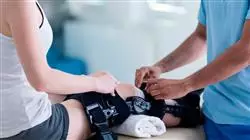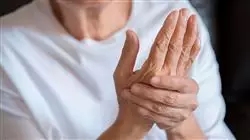University certificate
The world's largest faculty of nursing”
Introduction to the Program
Improve your knowledge in Acute, Postoperative and Musculoskeletal Pain Management. Rehabilitation and Physical Activity through this program, where you will find the best teaching material with real clinical cases”

Pain is one of the most frequent symptoms of disease presentation and is one of the main causes of consultation to the health system. Moreover, as health professionals, it can be found in its most varied manifestations in any job that is developed within the health system. This is why an adequate knowledge of its causes and management can be an excellent working tool in the development of daily professional activity.
The design of this program is based on learning based on up-to-date contents and practical cases that allow professionals to learn in an eminently practical environment. Throughout this program, you will address all the non-pharmacological tools for nursing practice in pain management.
Thanks to this program you will acquire the necessary knowledge for the holistic management of different types of pain in all care contexts, the ability to assess, evaluate, diagnose and intervene with a care plan, as well as autonomy in the patient's decisions and quality of life in the treatment of pain.
Take the opportunity and study this program in a 100% online format, without having to give up your obligations, from the comfort of your own home. Update your knowledge and study a program to continue growing personally and professionally.
Take the opportunity to learn about the latest advances in this field and apply it to your daily practice”
This Postgraduate diploma in Acute, Postoperative and Musculoskeletal Pain Management. Rehabilitation and Physical Activity contains the most complete and up-to-date scientific program on the market. The most important features include:
- The development of more than 75 clinical cases presented by experts in Acute, Postoperative and Musculoskeletal Pain Management. Rehabilitation and Physical Activity
- The graphic, schematic, and practical contents with which they are created provide scientific and practical information on the disciplines that are essential for professional practice
- Diagnostic and therapeutic novelties on evaluation, diagnosis and intervention in Acute, Postoperative and Musculoskeletal Pain Management. Rehabilitation and Physical Activity
- Practical exercises where the self-assessment process can be carried out to improve learning
- Clinical iconography and diagnostic imaging tests
- An algorithm-based interactive learning system for decision-making in the clinical situations presented throughout the course
- Special emphasis on the research methodology used in Acute, Postoperative and Musculoskeletal Pain Management. Rehabilitation and Physical Activity
- Theoretical lessons, questions to the expert, debate forums on controversial topics, and individual reflection assignments
- Access to content from any fixed or portable device with an Internet connection
This program may be the best investment you can make in selecting a refresher program for two reasons: in addition to updating your knowledge in used in Acute, Postoperative and Musculoskeletal Pain Management. Rehabilitation and Physical Activity, you will obtain a qualification from TECH Global University”
Its teaching staff includes health professionals from the main areas of pain, who bring to this program the experience of their work, as well as recognized specialists from leading societies and prestigious universities.
The multimedia content, developed with the latest educational technology, will provide the professional with situated and contextual learning, i.e., a simulated environment that will provide an immersive training experience designed to train for real-life situations.
This program is designed around Problem-Based Learning, whereby the nurse must try to solve the different professional practice situations that arise throughout the program. For this purpose, the specialist will be assisted by an innovative interactive video system developed by renowned experts with extensive experience in therapeutic personal training.
Increase your confidence in decision making by updating your knowledge through this program"

This program in Acute, Postoperative and Musculoskeletal Pain Management. Rehabilitation and Physical Activity will help you keep up to date in order to provide comprehensive quality care to your patients"
Why study at TECH?
TECH is the world’s largest online university. With an impressive catalog of more than 14,000 university programs available in 11 languages, it is positioned as a leader in employability, with a 99% job placement rate. In addition, it relies on an enormous faculty of more than 6,000 professors of the highest international renown.

Study at the world's largest online university and guarantee your professional success. The future starts at TECH”
The world’s best online university according to FORBES
The prestigious Forbes magazine, specialized in business and finance, has highlighted TECH as “the world's best online university” This is what they have recently stated in an article in their digital edition in which they echo the success story of this institution, “thanks to the academic offer it provides, the selection of its teaching staff, and an innovative learning method aimed at educating the professionals of the future”
A revolutionary study method, a cutting-edge faculty and a practical focus: the key to TECH's success.
The most complete study plans on the university scene
TECH offers the most complete study plans on the university scene, with syllabuses that cover fundamental concepts and, at the same time, the main scientific advances in their specific scientific areas. In addition, these programs are continuously being updated to guarantee students the academic vanguard and the most in-demand professional skills. In this way, the university's qualifications provide its graduates with a significant advantage to propel their careers to success.
TECH offers the most comprehensive and intensive study plans on the current university scene.
A world-class teaching staff
TECH's teaching staff is made up of more than 6,000 professors with the highest international recognition. Professors, researchers and top executives of multinational companies, including Isaiah Covington, performance coach of the Boston Celtics; Magda Romanska, principal investigator at Harvard MetaLAB; Ignacio Wistumba, chairman of the department of translational molecular pathology at MD Anderson Cancer Center; and D.W. Pine, creative director of TIME magazine, among others.
Internationally renowned experts, specialized in different branches of Health, Technology, Communication and Business, form part of the TECH faculty.
A unique learning method
TECH is the first university to use Relearning in all its programs. It is the best online learning methodology, accredited with international teaching quality certifications, provided by prestigious educational agencies. In addition, this disruptive educational model is complemented with the “Case Method”, thereby setting up a unique online teaching strategy. Innovative teaching resources are also implemented, including detailed videos, infographics and interactive summaries.
TECH combines Relearning and the Case Method in all its university programs to guarantee excellent theoretical and practical learning, studying whenever and wherever you want.
The world's largest online university
TECH is the world’s largest online university. We are the largest educational institution, with the best and widest online educational catalog, one hundred percent online and covering the vast majority of areas of knowledge. We offer a large selection of our own degrees and accredited online undergraduate and postgraduate degrees. In total, more than 14,000 university degrees, in eleven different languages, make us the largest educational largest in the world.
TECH has the world's most extensive catalog of academic and official programs, available in more than 11 languages.
Google Premier Partner
The American technology giant has awarded TECH the Google Google Premier Partner badge. This award, which is only available to 3% of the world's companies, highlights the efficient, flexible and tailored experience that this university provides to students. The recognition as a Google Premier Partner not only accredits the maximum rigor, performance and investment in TECH's digital infrastructures, but also places this university as one of the world's leading technology companies.
Google has positioned TECH in the top 3% of the world's most important technology companies by awarding it its Google Premier Partner badge.
The official online university of the NBA
TECH is the official online university of the NBA. Thanks to our agreement with the biggest league in basketball, we offer our students exclusive university programs, as well as a wide variety of educational resources focused on the business of the league and other areas of the sports industry. Each program is made up of a uniquely designed syllabus and features exceptional guest hosts: professionals with a distinguished sports background who will offer their expertise on the most relevant topics.
TECH has been selected by the NBA, the world's top basketball league, as its official online university.
The top-rated university by its students
Students have positioned TECH as the world's top-rated university on the main review websites, with a highest rating of 4.9 out of 5, obtained from more than 1,000 reviews. These results consolidate TECH as the benchmark university institution at an international level, reflecting the excellence and positive impact of its educational model.” reflecting the excellence and positive impact of its educational model.”
TECH is the world’s top-rated university by its students.
Leaders in employability
TECH has managed to become the leading university in employability. 99% of its students obtain jobs in the academic field they have studied, within one year of completing any of the university's programs. A similar number achieve immediate career enhancement. All this thanks to a study methodology that bases its effectiveness on the acquisition of practical skills, which are absolutely necessary for professional development.
99% of TECH graduates find a job within a year of completing their studies.
Postgraduate Diploma in Acute and Postoperative Pain Musculoskeletal Pain Rehabilitation and Physical Activity
Immerse yourself in the exciting field of acute and postoperative pain management in the musculoskeletal field, as well as rehabilitation and physical activity, through our Postgraduate Diploma program at TECH Global University. Discover the most effective strategies and techniques to relieve pain, promote recovery and optimize physical activity, all from the comfort of your home with our online classes. Acute and postoperative pain is a common concern in the musculoskeletal setting, whether as a result of injury, surgery or illness. As an expert in pain management and rehabilitation, you will be prepared to provide relief to your patients and promote their recovery through appropriate physical activity. Our Postgraduate Diploma program in Acute and Postoperative Musculoskeletal Pain Rehabilitation and Physical Activity will provide you with the specialized knowledge you need to excel in this field. You will learn about pain mechanisms, assessment techniques and therapeutic approaches to acute and postoperative pain relief.
Study so that you improve the quality of life of your students
By choosing our online classes, you will enjoy a number of remarkable benefits. You will have access to dynamic, quality educational material, taught by experts in the approach to pain and musculoskeletal rehabilitation. Our hands-on approach will allow you to apply your knowledge through case studies and practical exercises. In addition, you will have the flexibility to study at your own pace, adapting your learning to your schedule and personal commitments. TECH Global University is proud to offer programs of excellence, backed by our reputation as a leading institution in 100% online education. Join us in the Postgraduate Diploma in Acute and Postoperative and Musculoskeletal. Rehabilitation and Physical Activity and gain the skills you need to excel in the field of pain management and musculoskeletal rehabilitation, promoting the health and well-being of your patients.







